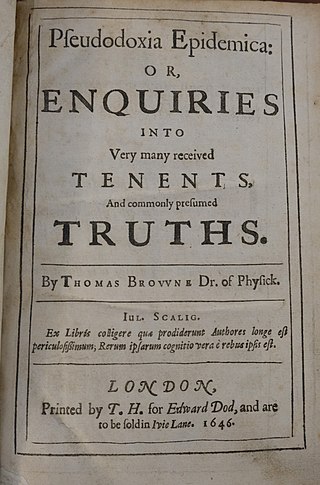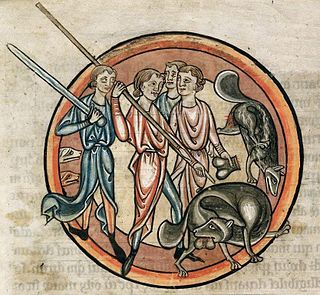Adamant in classical mythology is an archaic form of diamond. In fact, the English word diamond is ultimately derived from adamas, via Late Latin diamas and Old French diamant. In ancient Greek ἀδάμας, genitive ἀδάμαντος, literally 'unconquerable, untameable'. In those days, the qualities of hard metal were attributed to it, and adamant became as a result an independent concept.

Sir Thomas Browne was an English polymath and author of varied works which reveal his wide learning in diverse fields including science and medicine, religion and the esoteric. His writings display a deep curiosity towards the natural world, influenced by the Scientific Revolution of Baconian enquiry and are permeated by references to Classical and Biblical sources as well as the idiosyncrasies of his own personality. Although often described as suffused with melancholia, Browne's writings are also characterised by wit and subtle humour, while his literary style is varied, according to genre, resulting in a rich, unique prose which ranges from rough notebook observations to polished Baroque eloquence.
This article contains information about the literary events and publications of 1646.

Pseudodoxia Epidemica or Enquiries into very many received tenents and commonly presumed truths, also known simply as Pseudodoxia Epidemica or Vulgar Errors, is a work by Thomas Browne challenging and refuting the "vulgar" or common errors and superstitions of his age. It first appeared in 1646 and went through five subsequent editions, the last revision occurring in 1672. The work includes evidence of Browne's adherence to the Baconian method of empirical observation of nature, and was in the vanguard of work-in-progress scientific journalism during the 17th-century Scientific Revolution. Throughout its pages frequent examples of Browne's subtle humour can also be found.

In the religion of ancient Rome, a haruspex was a person trained to practise a form of divination called haruspicy, the inspection of the entrails of sacrificed animals, especially the livers of sacrificed sheep and poultry. Various ancient cultures of the Near East, such as the Babylonians, also read omens specifically from the liver, a practice also known by the Greek term hepatoscopy.
Opodeldoc is a medical plaster or liniment invented, or at least named, by the German Renaissance physician Paracelsus in the 1500s. In modern form opodeldoc is a mixture of soap in alcohol, to which camphor and sometimes a number of herbal essences, most notably wormwood, are added.

Jacques Gaffarel (1601–1681) was a French scholar and astrologer. He followed the family tradition of studying medicine, and then became a priest, but mainly developed his interests in the fields of natural history and Oriental occultism, gaining fluency in the Hebrew, Persian, and Arabic languages.

The Deipnosophistae is an early 3rd-century AD Greek work by the Greek author Athenaeus of Naucratis. It is a long work of literary, historical, and antiquarian references set in Rome at a series of banquets held by the protagonist Publius Livius Larensis for an assembly of grammarians, lexicographers, jurists, musicians, and hangers-on.

A wand is a thin, light-weight rod that is held with one hand, and is traditionally made of wood, but may also be made of other materials, such as metal, plastic or stone. Long versions of wands are often styled in forms of staves or sceptres, which could have large ornamentation on the top.

Spodomancy is a form of divination by examining cinders, soot, or ashes, particularly although not exclusively from a ritual sacrifice. Spodomancy has been practiced by numerous cultures, ancient and modern, across the globe. While many practitioners have performed the ritual as part of a formal system of paranormal, religious, or ceremonial magic, many have done so as part of mere folkloric practice or superstition.
The word electricity derives from Neo-Latin and ultimately Greek. It first appears in English in Francis Bacon's writings. Depending on context, the word may refer to "electric charge", "electric power" or "electric energy".
Belomancy, also bolomancy, is the ancient art of divination by use of arrows. The word is built upon Ancient Greek: βέλος, romanized: belos, lit. 'arrow, dart', and μαντεία, manteia, 'divination'. Belomancy was anciently practised at least by Babylonians, Greeks, Arabs and Scythians.

In the magico-medical tradition of Europe and the Near East, the aetites or aetite (anglicized) is a stone used to promote childbirth. It is also called an eagle-stone, aquiline, or aquilaeus. The stone is said to prevent spontaneous abortion and premature delivery, while shortening labor and birth for a full-term birth.

The Vegetable Lamb of Tartary is a legendary zoophyte of Central Asia, once believed to grow sheep as its fruit. It was believed the sheep were connected to the plant by an umbilical cord and grazed the land around the plant. When all accessible foliage was gone, both the plant and sheep died.
Methods of divination can be found around the world, and many cultures practice the same methods under different names. During the Middle Ages, scholars coined terms for many of these methods—some of which had hitherto been unnamed—in Medieval Latin, very often utilizing the suffix -mantia when the art seemed more mystical and the suffix -scopia when the art seemed more scientific. Names like drimimantia, nigromantia, and horoscopia arose, along with other pseudosciences such as phrenology and physiognomy.
Plato was an ancient Greek philosopher, the second of the trio of ancient Greeks including Socrates and Aristotle said to have laid the philosophical foundations of Western culture.
Christian Kabbalah arose during the Renaissance due to Christian scholars' interest in the mysticism of Jewish Kabbalah, which they interpreted according to Christian theology. It is often transliterated as Cabala to distinguish it from the Jewish form and from Hermetic Qabalah.

The Cyranides is a compilation of magico-medical works in Greek first put together in the 4th century. Latin and Arabic translations also exists. It has been described as a "farrago" and a texte vivant, owing to the complexities of its transmission: it has been abridged, rearranged, and supplemented. The resulting compilation covers the magical properties and practical uses of gemstones, plants, and animals, and is a virtual encyclopedia of amulets; it also contains material pertinent to the history of western alchemy, and to New Testament studies, particularly in illuminating meanings of words and magico-religious practices. As a medical text, the Cyranides was held in relatively low esteem even in antiquity and the Middle Ages because of its use of vernacular language and reliance on lore rather than Hippocratic or Galenic medical theory.

A sceptre is a staff or wand held in the hand by a ruling monarch as an item of royal or imperial insignia, signifying sovereign authority.

In ancient times, the beaver was hunted for its testicles, which it was thought had medicinal qualities. The story that the animal would gnaw these off to save itself when hunted was preserved by some ancient Greek naturalists and perpetuated into the Middle Ages. It also appeared as a Greek fable ascribed to Aesop and is numbered 118 in the Perry Index.











